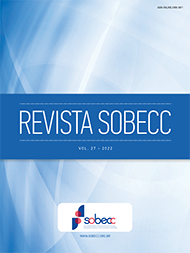Surgical Map Panel as Patient Safety and Communication Tool
DOI:
https://doi.org/10.5327/Z1414-4425202227794Keywords:
Automação, painel eletrônico, mapa cirurgico, mapa cirurgico eletrônico,Abstract
: Objective: To report the development and implementation of a surgical map panel with automated view of information about the surgery, team, status, risks and preoperative preparation. Method: Experience report on the development and implementation of a visual panel for surgical map, status, risks and patient preparation that aims to improve multiprofessional communication and follow-up of patient preparation workflow, in a large charity hospital in the city of São Paulo, from August 2021 to February 2022. Results: The process took place in four stages: understanding the business rules; identifying iconograms that would compose the panel; product development and feature testing; implementation in a productive environment, presenting the technology to the medical and nursing staff. Conclusion: The new surgical panel is colored, where iconograms are quickly identified and help in the communication, safety and assistance by the multidisciplinary team, facilitating workflows and allowing early intervention to potential risks.
References
World Health Organization (WHO). Management of patient information: trends and challenges in Member States: based on the findings of the second global survey on eHealth. Global Observatory for eHealth series [Internet]. 2012 [acesso em 28 fevereiro de 2022]; (6):74p. Disponível em: https://apps.who.int/iris/bitstream/handle/10665/76794/9789241504645_eng.pdf?sequence=1&isAllowed=y
Organisation for Economic Cooperation and Development/Europe. Health at a Glance: Europe 2018: State of Health in the EU Cycle. Paris (FR): OECD Publishing. 2018. https://doi.org/10.1787/health_glance_eur-2018-en
Lopes JE, Heimann CE. Uso das tecnologias da informação e comunicação nas ações médicas a distância: um caminho promissor a ser investido na saúde pública. J. Health Inform [Internet]. 2016;[acesso em 01 março de 2022]; 8(1):26-30. Disponível em: http://www.jhi-sbis.saude.ws/ojs-jhi/index.php/jhi-sbis/article/view/364
Sorra J, Famolaro T, Yount N, Smith S, Behm, J. Results From the 2014 Pilot Study of the AHRQ SOPSTM Value and Efficiency Supplemental Items for the Hospital Survey. Rockville, MD: Agency for Healthcare Research and Quality [Internet]. 2017 [acesso em 28 fevereiro de 2022]. AHRQ Publication No. 18-0012-EF. Disponível em: https://www.ahrq.gov/sites/default/files/wysiwyg/sops/quality-patient-safety/patientsafetyculture/hospitalvaluepilotreport.pdf
Moraes AFSPL, Wolff LDG, Silvestre AL, Gonçalves LS, Rosa SCS. Tecnologias da informação e comunicação em saúde e a segurança do paciente. J Health Inform [Internet].2020 [acesso em 01 março de 2022]:300-6. Disponível em: http://www.jhi-sbis.saude.ws/ojs-jhi/index.php/jhi-sbis/article/view/830
Martins L, Sartor GD, Silva MP. Prontuário Eletrônico do Paciente: Adoção de novas tecnologias de acesso. J Health Inform [Internet] 2019 [acesso em 01 março de 2022];11(3):67-73. Disponível em: http://www.jhi-sbis.saude.ws/ojs-jhi/index.php/jhi-sbis/article/view/608
Soares CR, Peres HHC, Oliveira NB. Processo de Enfermagem: revisão integrativa sobre as contribuições da informática. J Health Inform [Internet]. 2018 [acesso em 01 março de 2022];10(4):112-8. Disponível em: http://www.jhi-sbis.saude.ws/ojs-jhi/index.php/jhi-sbis/article/view/550
Furukawa MF, Eldridge N, Wang Y, Metersky M. Electronic Health Record Adoption and Rates of In-hospital Adverse Events. Journal of Patient Safety 2020 jun.;16(2):137-142. http://doi.org/10.1097/PTS.0000000000000257
Fuller Rm Hansen A. Disruption ahead navigating and leading the future of nursing. Nurs Adm Q.2019;43(3):212-21. http://doi.org./10.1097/NAQ.0000000000000354.
Vaz TA, Avila AM, Pasin S, Lucena AF, Goerk G, Pozza CD, et al. Informatização dos painéis de pacientes em unidades de internação no HCPA.Clin Biomed Res [Internet]. 2018 [acesso 02 março de 2022];38(supl):150. Disponível em: https://www.lume.ufrgs.br/bitstream/handle/10183/207742/001088122.pdf?sequence=1
Ribeiro NT, Biancolino CA.Implantação de painel eletrônico de status de cirurgias na sala de espera de centro cirúrgico como ferramenta de comunicação just in time. XVII SEMEAD [Internet]. 2014[acesso 02 março de 2022]. Disponível em: http://sistema.semead.com.br/17semead/resultado/trabalhosPDF/410.pdf
Mota DN, Torres RA, Guimarães JM, Marinho MN, Araújo AF. Information and communication technologies: influences in the work of the Family Health strategy. J Health Inform [Internet]. 2018 [acesso em 02 março de 2022];10(2):45-9. Disponível em: http://www.jhi-sbis.saude.ws/ojs-jhi/index. php/jhi-sbis/article/view/563/330
Ferreira AM, Oliveira JL, Camillo NR, Reis GA, Évora YD, Matsuda LM. Perceptions of nursing professionals about the use of patient safety computerization. Rev Gaúcha Enferm. 2019;40(Spe):e20180140. https://doi.org/10.1590/1983- 1447.2019.20180140
Downloads
Published
How to Cite
Issue
Section
License
Copyright (c) 2022 Cristina Silva Sousa, Andrea Alfaya Acunã

This work is licensed under a Creative Commons Attribution 4.0 International License.
By publishing in Revista SOBECC, authors retain the copyright of their article and agree to license their work using a Creative Commons Attribution (CC BY 4.0) International Public License, thus accepting the terms of this license. The CC BY 4.0 license allows others to distribute, remix, adapt, and create from the published article, even for commercial purposes, provided they give due credit to the creators of the work (authors of the article).
The authors grant to Revista SOBECC the right of first publication, to identify itself as the original publisher, and grant to the journal a non-exclusive license to use the work in the following ways: (1) to sell and/or distribute the article in hard copies and/or in electronic format; (2) to distribute parts and/or the entire article in order to promote the journal through the internet and other digital and printed media; (3) to record and reproduce the article in any format, including digital media.
With this license, authors can enter into separate contracts for non-exclusive distribution of the article (e.g., publishing in an institutional repository or as a book chapter), with acknowledgement of authorship and initial publication in Revista SOBECC. Authors are encouraged to publish and distribute their work online after publication in the Revista SOBECC, as this can increase the article's visibility and impact.
In line with the journal's policies, each published article will be assigned a CC BY 4.0 license, which will be visible on the abstract page and in the PDF of each article with the respective link to the license terms.











